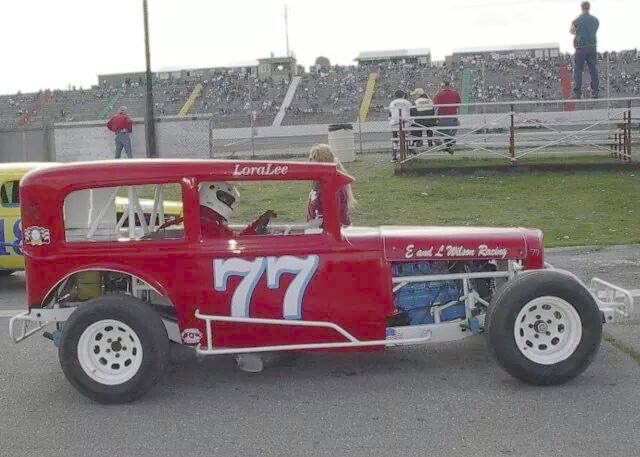Early Stock Class Brings Back Memories
SPOKANE — When the local Early Stock class chugs out on the track to race at Stateline Speedway some may wonder just where all these old cars came from?
Certainly not out of a box?
They are,, in fact, a microcosm of a large segment of racing history in the Inland Northwest.
“When I was a kid my dad would take me to the races at the Fairgrounds,” Steve Spalding, one of the current drivers said. “As a kid you aways had your favorite drivers and my favorite class was the C stock class,” now reborn as the Early Stocks.
The C class were open wheel 1929-1940 coupes and sedans. These cars could be built from wrecking yards and old bodies could be found in a farmer’s field. They would be powered by a six-cylinder motor with a one-barrel carburetor with a straight axle front end, Spalding explained.

Racing action at the old Mead Speedway and Memorial (Joe Albi) Stadium featured the predecessors of today’s Early Stocks. Check out the stadium scoreboard. Photo courtesy of Ed Hudson.
“This made this class very affordable and easy to build or buy,” he said.
Many of the big names cut their teeth in this class: Gary Honeyman, Clancy Kirk, Randy Johnson, Monte Zema, the Sneva and Hudson brothers (Ed & Hal), Jim Cosner and Don Harris, among others. And the list goes on and on.
“This class honors the past of racing, every little town and every fairground had such a class,” Spalding said.
But the class predates the Fairgrounds, according to Ed Hudson.
“Some of Spokane’s great made their names at Mead, Ed Sneva and Earl Wham, two drivers to be reckoned with,” Hudson wrote in a brief history of the class.
Between the end of the Mead Speedway and birth of the Fairgrounds, racing took place at Memorial Stadium (Joe Albi) in the early 1950s, later at Stateline Gardens in Idaho and then Sunset Speedway a 3/8’s banked dirt oval — not to be confused with the current dirt karting track.
“Tom, Jerry and Jan Sneva all started in the Early Stocks,” Hudson said. “Plus, they made the transition to the ultimate stage for open wheel racers, the Indianapolis 500. Tom won the 500 in 1983.”
According to Spalding, “The class made some huge changes and the class died.”
Many of the cars got scrapped or sold to go up north to the dirt tracks. Many of the drivers made a new class the Northwest Modifieds which is still running today.
“This class was absent from Spokane for many years,” Spalding recalls, but one weekend a traveling group of racers from Canada and Oregon raced such a car on a stop at Stateline.
It was the same type of cars that Spalding grew up watching as a kid. They would get together and race 4-6 races around the 4th of July week, tracks in Montana, Idaho and Washington.
So launched the rebirth of the local class.
“Rossy Rocket” was the founding father of the Canadian group,” Spalding said. His car was retired and in a racing museum on Victoria Island sitting beside Tom Sneva’s Tipke Indy car.
“Ross called me one night and said that the car was getting pulled out of the museum and that he wanted me to buy it,” Spalding recalled. “I was the only Spokane car for a short time.”
If was the classic example of if you build it and they will come.

The former Sneva C-class car that was driven by LoraLee Wilson, the longest continuing driver in the Early Stocks club. Photo courtesy of Steve Spalding.
It started with Spalding’s car, but Frank Voltz and Larry Martin built many cars in the next few years. Duncan Behar, Bob Young, Pete Munk, Terry Armstrong and the Wilson Family would get their own cars as well.
“The cool thing was it was the same class with the same rules we had at the Fairgrounds,” Spalding said.
The class currently uses largely the same rules at the C-stocks except safety issues.
“Today we have young and old racers, girls and guys in this class,” Spalding said. “Yes, we still have Rossy Rockets and a Sneva car racing in the club,” he added.

